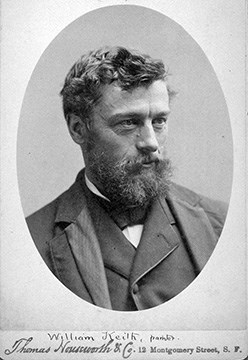
Public Domain The Artist FriendJohn Muir cultivated lasting friendships with individuals from various backgrounds, including educators, scientists, writers, artists, philosophers, mountaineers, and confidants. Among these was the renowned landscape painter William Keith, whose companionship with Muir spanned nearly four decades. Their friendship began in October 1872 when Keith visited Yosemite Valley carrying a letter of introduction from Jeanne Carr, a mutual friend. Accompanied by Floy Hutchings, Keith and two other painters sought out Muir at his cabin near the Royal Arches. Keith asked Muir for suggestions on picturesque locations, and Muir enthusiastically agreed to guide them. Two days later, the group, which included Muir, Keith, Irwin Benoni, Thomas Ross, and Merrill Moores, set out for the upper Tuolumne River area. Muir and Keith quickly discovered their shared roots, both having been born in Scotland in the same year, and this connection formed the foundation of their enduring friendship. Keith later reflected on their adventure in his journal, describing the stunning autumn landscape around Mount Lyell, where vibrant yellows and reds stood out against the cool tones of the pines, rocks, and snow. He called it "the grandest thing I ever saw." Muir’s account of Keith’s reaction was more animated, depicting Keith as bursting with enthusiasm, gesturing wildly at the view. While Keith appreciated their outdoor excursions, he humorously noted Muir’s minimalist approach to provisions, lamenting the monotony of bread, dried meat, and sugarless coffee. The two friends embarked on several expeditions together over the years, including trips to Tuolumne Canyon with Jeanne Carr and Albert Kellogg in 1873, Yosemite Creek to Mono Lake in 1875 with John Swett and J.B. McChesney, Mount Shasta in 1888, and Muir Woods in 1908. Despite their close bond, they often debated their artistic methods. Keith began his career focusing on meticulous detail in his paintings, much to Muir’s approval. However, as Keith’s style evolved into a more impressionistic approach, Muir playfully criticized him for abandoning detail. Similarly, Keith teased Muir about removing excessive detail from his writing. One notable instance of Keith supporting Muir occurred in 1876 when Muir was anxious about delivering his first public lecture in Sacramento. Keith lent Muir one of his paintings, The Headwaters of the Merced, encouraging him to display it at the church to help him relax. The painting, depicting a familiar scene, provided Muir with comfort and inspiration, leading to a successful presentation. Keith’s artworks were cherished in the Muir family home, with pieces like Yosemite, Tuolumne Meadows, Mt. Shasta, and Sierra Scene adorning their walls. Some of Keith’s paintings, such as portraits of Dr. and Mrs. Strentzel, now reside in the County Museum in Martinez, while others are preserved in collections like the Hearst Art Gallery at St. Mary’s College in Moraga. Among these is Mt. Lyell, based on sketches from his 1872 trip with Muir, a testament to their shared experiences and enduring friendship. |
Last updated: December 19, 2024
